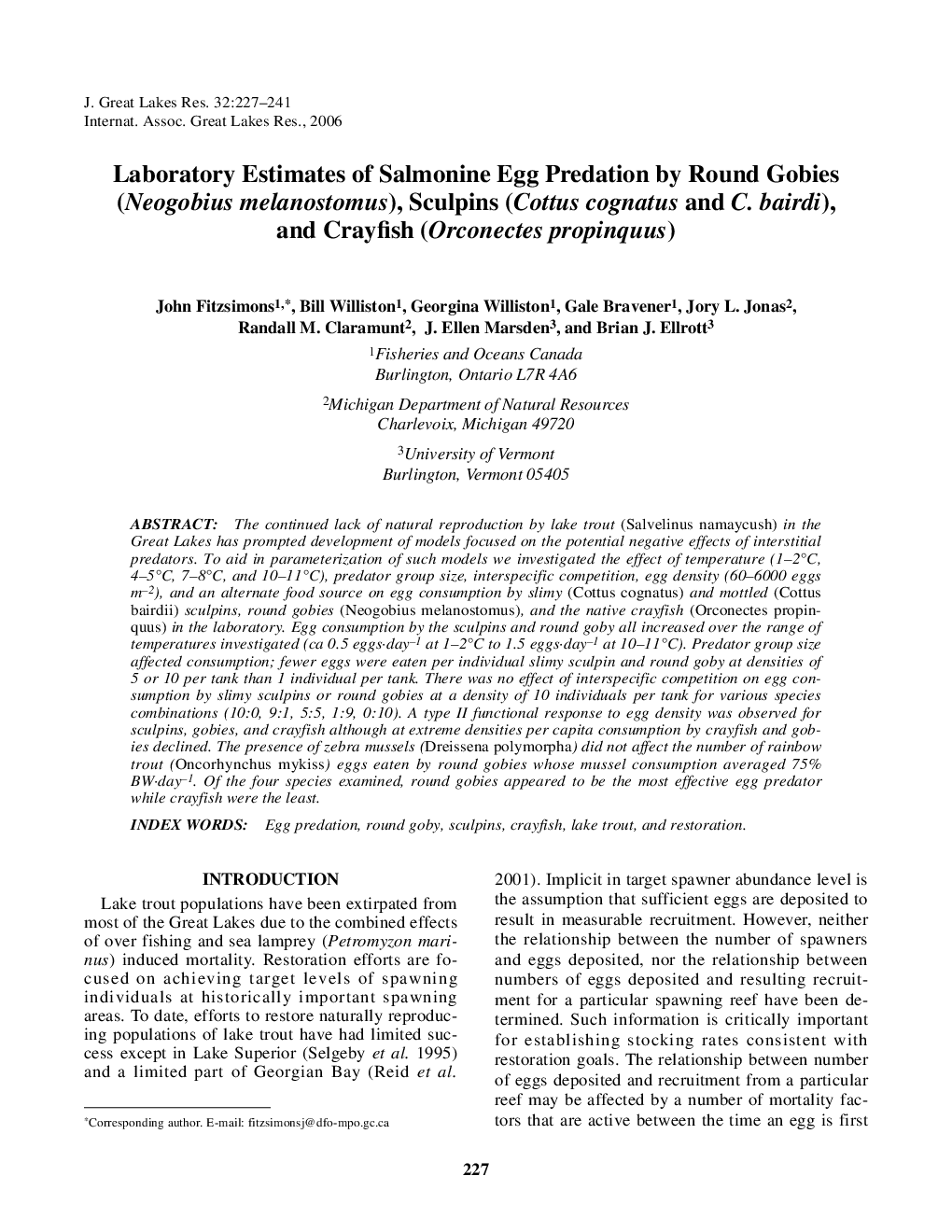| کد مقاله | کد نشریه | سال انتشار | مقاله انگلیسی | نسخه تمام متن |
|---|---|---|---|---|
| 4398899 | 1306709 | 2006 | 15 صفحه PDF | دانلود رایگان |
عنوان انگلیسی مقاله ISI
Laboratory Estimates of Salmonine Egg Predation by Round Gobies (Neogobius melanostomus), Sculpins (Cottus cognatus and C. bairdi), and Crayfish (Orconectes propinquus)
دانلود مقاله + سفارش ترجمه
دانلود مقاله ISI انگلیسی
رایگان برای ایرانیان
کلمات کلیدی
موضوعات مرتبط
مهندسی و علوم پایه
علوم زمین و سیارات
علوم زمین و سیاره ای (عمومی)
پیش نمایش صفحه اول مقاله

چکیده انگلیسی
The continued lack of natural reproduction by lake trout (Salvelinus namaycush) in the Great Lakes has prompted development of models focused on the potential negative effects of interstitial predators. To aid in parameterization of such models we investigated the effect of temperature (1-2°C, 4-5°C, 7-8°C, and 10-11°C), predator group size, interspecific competition, egg density (60-6000 eggs m-2), and an alternate food source on egg consumption by slimy (Cottus cognatus) and mottled (Cottus bairdii) sculpins, round gobies (Neogobius melanostomus), and the native crayfish (Orconectes propinquus) in the laboratory. Egg consumption by the sculpins and round goby all increased over the range of temperatures investigated (ca 0.5 eggs·day-1 at 1-2°C to 1.5·eggs day-1 at 10-11°C). Predator group size affected consumption; fewer eggs were eaten per individual slimy sculpin and round goby at densities of 5 or 10 per tank than 1 individual per tank. There was no effect of interspecific competition on egg consumption by slimy sculpins or round gobies at a density of 10 individuals per tank for various species combinations (10:0, 9:1, 5:5, 1:9, 0:10). A type II functional response to egg density was observed for sculpins, gobies, and crayfish although at extreme densities per capita consumption by crayfish and gobies declined. The presence of zebra mussels (Dreissena polymorpha) did not affect the number of rainbow trout (Oncorhynchus mykiss) eggs eaten by round gobies whose mussel consumption averaged 75% BW·day-1. Of the four species examined, round gobies appeared to be the most effective egg predator while crayfish were the least.
ناشر
Database: Elsevier - ScienceDirect (ساینس دایرکت)
Journal: Journal of Great Lakes Research - Volume 32, Issue 2, 2006, Pages 227-241
Journal: Journal of Great Lakes Research - Volume 32, Issue 2, 2006, Pages 227-241
نویسندگان
John Fitzsimons, Bill Williston, Georgina Williston, Gale Bravener, Jory L. Jonas, Randall M. Claramunt, J. Ellen Marsden, Brian J. Ellrott,